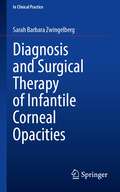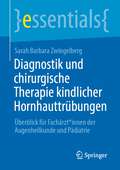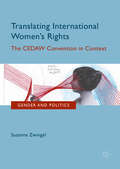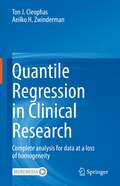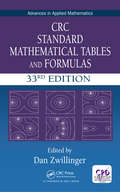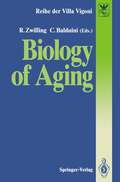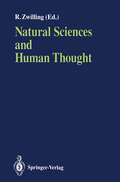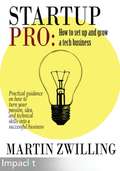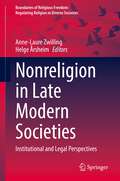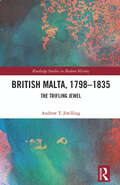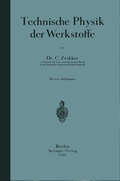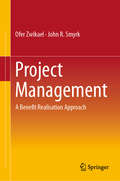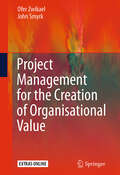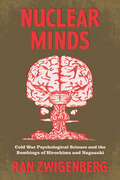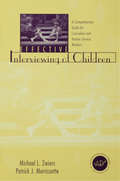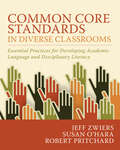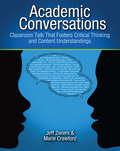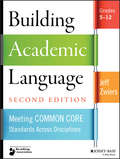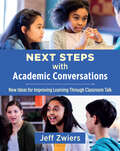- Table View
- List View
Diagnostik und chirurgische Therapie kindlicher Hornhauttrübungen: Überblick für Fachärzt*innen der Augenheilkunde und Pädiatrie (essentials)
by Sarah Barbara ZwingelbergDie kindliche Hornhauttrübung gehört weltweit zu den Hauptursachen für Blindheit oder eine schwere Sehbehinderung bei Kindern. Die Ursachen sind hierbei vielfältig und komplex und besitzen ein enges therapeutisches Fenster aufgrund des erhöhten Risikos der Entwicklung einer Amblyopie. Dieses Essential gibt einen komprimierten Überblick zur Diagnostik, Klinik, Genetik und den aktuellen Behandlungsmöglichkeiten von angeborenen Hornhauttrübungen und Dysgenesie des vorderen Augenabschnitts.
Translating International Women's Rights: The CEDAW Convention in Context (Gender and Politics)
by Susanne ZwingelThis book looks at the centerpiece of the international women’s rights discourse, the Convention on the Elimination of all Forms of Discrimination against Women (CEDAW), and asks to what extent it affects the lives of women worldwide. Rather than assuming a trickle-down effect, the author discusses specific methods which have made CEDAW resonate. These methods include attempts to influence the international level by clarifying the meaning of women’s rights and strengthening the Convention’s monitoring procedure, and building connections between international and domestic contexts that enable diverse actors to engage with CEDAW. This analysis shows that while the Convention has worldwide impact, this impact is fundamentally dependent on context-specific values and agency. Hence, rather than thinking of women’s rights exclusively as normative content, Zwingel suggests to see them as in process. This book will especially appeal to students and scholars interested in transnational feminism and gender and global governance.
Quantile Regression in Clinical Research: Complete analysis for data at a loss of homogeneity
by Aeilko H. Zwinderman Ton J. CleophasQuantile regression is an approach to data at a loss of homogeneity, for example (1) data with outliers, (2) skewed data like corona - deaths data, (3) data with inconstant variability, (4) big data. In clinical research many examples can be given like circadian phenomena, and diseases where spreading may be dependent on subsets with frailty, low weight, low hygiene, and many forms of lack of healthiness. Stratified analyses is the laborious and rather explorative way of analysis, but quantile analysis is a more fruitful, faster and completer alternative for the purpose. Considering all of this, we are on the verge of a revolution in data analysis. The current edition is the first textbook and tutorial of quantile regressions for medical and healthcare students as well as recollection/update bench, and help desk for professionals. Each chapter can be studied as a standalone and covers one of the many fields in the fast growing world of quantile regressions. Step by step analyses of over 20 data files stored at extras.springer.com are included for self-assessment. We should add that the authors are well qualified in their field. Professor Zwinderman is past-president of the International Society of Biostatistics (2012-2015) and Professor Cleophas is past-president of the American College of Angiology(2000-2002). From their expertise they should be able to make adequate selections of modern quantile regression methods for the benefit of physicians, students, and investigators.
CRC Standard Mathematical Tables and Formulas (Advances in Applied Mathematics)
by Daniel ZwillingerContaining more than 6,000 entries, CRC Standard Mathematical Tables and Formulas, 33rd Edition continues to provide essential formulas, tables, figures and detailed descriptions. The newest edition of this popular series also features many diagrams, group tables, and integrals that are not available online. This edition also incorporates important topics such as max plus algebra, financial options, pseudospectra, and proof methods. Newly updated topics reflecting new results include couple analogues, radar, and significant equations of mathematics. New features of the 33rd edition include: Larger trim size, five new topics, and topics which have been modified to update results Provides practical, ready-to-use information and covers important topics that are unfamiliar to many readers, such as visual proofs and sequences Includes hard-to-find and more complete information than found in the Internet such as table of conformal mappings and integral tables Adds descriptions of new functions: Lambert, prolate spheroidal, and Weierstrass Even though the book has been updated it retains the same successful format of previous editions in that material is still presented in a multi-sectional format.
Biology of Aging (Reihe der Villa Vigoni #1)
by Robert Zwilling Cesare Balduinibhe aim of the book was not to focus the age-dependent modifications of one specific biological systems or phenomena, but the attempt was pursued to cover several fields in which the biological research on aging is going on. The fundamental purpose of this planning was to offer the PhD students an advanced text that could raise the possibility of an interdisciplinary discussion on a wide and complex field that is very suitable to be utilized as an example of the connection existing between advanced teaching and experimental research.
Natural Sciences and Human Thought
by Robert ZwillingLeaving aside for once all utilitarian considerations, this book attempts to demonstrate the role and influence of the natural sciences in the development of human thought and in shaping the way in which we perceive the world. This seems to be particularly necessary in the present day and age, in view of the fact that a large section of the public is scarcely aware of the great cultural contribution that the natural sciences make towards moulding our conception of the world and scarcely acknowledges their function in helping us to find our bearings in a world that is becoming increasingly complex.
StartupPro: How to set up and grow a tech business
by Martin ZwillingIf your find yourself daydreaming about your own business and not just your next promotion, this book will help you shape your ideas as you begin your enrepreneurial journey.
Nonreligion in Late Modern Societies: Institutional and Legal Perspectives (Boundaries of Religious Freedom: Regulating Religion in Diverse Societies)
by Anne-Laure Zwilling Helge ÅrsheimThis volume presents results from new and ongoing research efforts into the role of nonreligion in education, politics, law and society from a variety of different countries. Featuring data from a wide range of quantitative and qualitative studies, the book exposes the relational dynamics of religion and nonreligion. Firstly, it highlights the extent to which nonreligion is defined and understood by legal and institutional actors on the basis of religions, and often replicates the organisation of society and majority religions. At the same time, it displays how essential it is to approach nonreligion on its own, by freeing oneself from the frameworks from which religion is thought.The book addresses pressing questions such as: How can nonreligion be defined, and how can the “nones” be grasped and taken into account in studies on religion? How does the sociocultural and religious backdrop of different countries affect the regulation and representation of nonreligion in law and policymaking? Where and how do nonreligious individuals and collectives fit into institutions in contemporary societies? How does nonreligion affect notions of citizenship and national belonging? Despite growing scholarly interest in the increasing number of people without religion, the role of nonreligion in legal and institutional settings is still largely unexplored.This volume helps fill the gap, and will be of interest to students, researchers, policymakers and others seeking deeper understanding of the changing role of nonreligion in modern societies.
British Malta, 1798–1835: The Trifling Jewel (Routledge Studies in Modern History)
by Andrew T. ZwillingBritish Malta, 1798–1835 explores the incorporation and early administration of Malta as a British protectorate, and later as a Crown colony.Few connections existed between Great Britain and Malta before 1798, but Napoleon’s Mediterranean ambitions forged a link that remained even after the expulsion of the French. Malta’s incorporation into the British Empire encountered numerous and varied challenges: a deadly plague, diplomatic rows, economic rebuilding, continual food supply obstacles, and the unique challenge of governing a long-subjugated population. The Maltese people spent the previous 228 years ruled by an anachronistic crusading order that they were barred from joining. While most sought the protection of the British government, many also strove for more Maltese autonomy and agency. This tension helped define the first three and a half decades of British rule in Malta. Reaching beyond the traditional periodization of the Napoleonic era, this book provides a broader context of the fitful growth of the British Empire.Scholars and general readers drawn to the history of Malta, the British Mediterranean, and the expansion of the British Empire will find value in this narrative history.
British Malta, 1798–1835: The Trifling Jewel (Routledge Studies in Modern History)
by Andrew T. ZwillingBritish Malta, 1798–1835 explores the incorporation and early administration of Malta as a British protectorate, and later as a Crown colony.Few connections existed between Great Britain and Malta before 1798, but Napoleon’s Mediterranean ambitions forged a link that remained even after the expulsion of the French. Malta’s incorporation into the British Empire encountered numerous and varied challenges: a deadly plague, diplomatic rows, economic rebuilding, continual food supply obstacles, and the unique challenge of governing a long-subjugated population. The Maltese people spent the previous 228 years ruled by an anachronistic crusading order that they were barred from joining. While most sought the protection of the British government, many also strove for more Maltese autonomy and agency. This tension helped define the first three and a half decades of British rule in Malta. Reaching beyond the traditional periodization of the Napoleonic era, this book provides a broader context of the fitful growth of the British Empire.Scholars and general readers drawn to the history of Malta, the British Mediterranean, and the expansion of the British Empire will find value in this narrative history.
Technische Physik der Werkstoffe
by C. ZwikkerDieser Buchtitel ist Teil des Digitalisierungsprojekts Springer Book Archives mit Publikationen, die seit den Anfängen des Verlags von 1842 erschienen sind. Der Verlag stellt mit diesem Archiv Quellen für die historische wie auch die disziplingeschichtliche Forschung zur Verfügung, die jeweils im historischen Kontext betrachtet werden müssen. Dieser Titel erschien in der Zeit vor 1945 und wird daher in seiner zeittypischen politisch-ideologischen Ausrichtung vom Verlag nicht beworben.
Project Management: A Benefit Realisation Approach
by Ofer Zwikael John R. SmyrkThis book is a complete project management toolkit for project leaders in business, research and industry.Projects are approved and financed to generate benefits. Project Management: A Benefit Realisation Approach proposes a complete framework that supports this objective – from project selection and definition, through execution, and beyond implementation of deliverables until benefits are secured. The book is the first to explain the creation of organisational value by suggesting a complete, internally-consistent and theoretically rigorous benefit-focused project management methodology, supported with an analytical technique: benefit engineering. Benefit engineering offers a practical approach to the design and maintenance of an organisation’s project portfolio. Building upon the authors’ earlier successful book, Project Management for the Creation of Organisational Value, this comprehensively revised and expanded new book contains the addition of new chapters on project realisation. The book offers a rigorous explanation of how benefits emerge from a project. This approach is developed and strengthened — resulting in a completely client-oriented view of a project.Senior executives, practitioners, students and academics will find in this book a comprehensive guide to the conduct of projects, which includes robust models, a set of consistent principles, an integrated glossary, enabling tools, illustrative examples and case studies.
Project Management for the Creation of Organisational Value
by Ofer Zwikael John SmyrkProjects and programmes are approved and funded to generate benefits. Project Management for the Creation of Organisational Value proposes a complete framework that seeks to support such an objective – from project selection and definition, through execution, and beyond implementation of deliverables until benefits are secured.Because it is preoccupied with deliverables, accepted project management practice is flawed. Project Management for the Creation of Organisational Value proposes an alternative approach, which seeks a flow of target outcomes for the organisation investing in the project.Project Management for the Creation of Organisational Value provides support for all those who play a role of leadership in projects at different levels. Senior executives, practitioners and academics will find in this book a comprehensive guide to the conduct of projects and programmes, which includes robust models, a set of consistent principles, an integrated glossary, enabling tools, illustrative examples and case studies.A companion workbook to this text for instructors and students is available online at http://extras.springer.com. The workbook illustrates project management concepts using the approach presented in this book and contains a range of exercises.
Nuclear Minds: Cold War Psychological Science and the Bombings of Hiroshima and Nagasaki
by Ran ZwigenbergHow researchers understood the atomic bomb’s effects on the human psyche before the recognition of Post-Traumatic Stress Disorder. In 1945, researchers on a mission to Hiroshima with the United States Strategic Bombing Survey canvassed survivors of the nuclear attack. This marked the beginning of global efforts—by psychiatrists, psychologists, and other social scientists—to tackle the complex ways in which human minds were affected by the advent of the nuclear age. A trans-Pacific research network emerged that produced massive amounts of data about the dropping of the bomb and subsequent nuclear tests in and around the Pacific rim. Ran Zwigenberg traces these efforts and the ways they were interpreted differently across communities of researchers and victims. He explores how the bomb’s psychological impact on survivors was understood before we had the concept of post-traumatic stress disorder. In fact, psychological and psychiatric research on Hiroshima and Nagasaki rarely referred to trauma or similar categories. Instead, institutional and political constraints—most notably the psychological sciences’ entanglement with Cold War science—led researchers to concentrate on short-term damage and somatic reactions or even, in some cases, on denial of victims’ suffering. As a result, very few doctors tried to ameliorate suffering. But, Zwigenberg argues, it was not only that doctors “failed” to issue the right diagnosis; the victims’ experiences also did not necessarily conform to our contemporary expectations. As he shows, the category of trauma should not be used uncritically in a non-Western context. Consequently, this book sets out, first, to understand the historical, cultural, and scientific constraints in which researchers and victims were acting and, second, to explore how suffering was understood in different cultural contexts before PTSD was a category of analysis.
Nuclear Minds: Cold War Psychological Science and the Bombings of Hiroshima and Nagasaki
by Ran ZwigenbergHow researchers understood the atomic bomb’s effects on the human psyche before the recognition of Post-Traumatic Stress Disorder. In 1945, researchers on a mission to Hiroshima with the United States Strategic Bombing Survey canvassed survivors of the nuclear attack. This marked the beginning of global efforts—by psychiatrists, psychologists, and other social scientists—to tackle the complex ways in which human minds were affected by the advent of the nuclear age. A trans-Pacific research network emerged that produced massive amounts of data about the dropping of the bomb and subsequent nuclear tests in and around the Pacific rim. Ran Zwigenberg traces these efforts and the ways they were interpreted differently across communities of researchers and victims. He explores how the bomb’s psychological impact on survivors was understood before we had the concept of post-traumatic stress disorder. In fact, psychological and psychiatric research on Hiroshima and Nagasaki rarely referred to trauma or similar categories. Instead, institutional and political constraints—most notably the psychological sciences’ entanglement with Cold War science—led researchers to concentrate on short-term damage and somatic reactions or even, in some cases, on denial of victims’ suffering. As a result, very few doctors tried to ameliorate suffering. But, Zwigenberg argues, it was not only that doctors “failed” to issue the right diagnosis; the victims’ experiences also did not necessarily conform to our contemporary expectations. As he shows, the category of trauma should not be used uncritically in a non-Western context. Consequently, this book sets out, first, to understand the historical, cultural, and scientific constraints in which researchers and victims were acting and, second, to explore how suffering was understood in different cultural contexts before PTSD was a category of analysis.
Effective Interviewing of Children: A Comprehensive Guide for Counselors and Human Service Workers
by Michael Zwiers Patrick J. MorrissetteFirst published in 1999. Routledge is an imprint of Taylor & Francis, an informa company.
Effective Interviewing of Children: A Comprehensive Guide for Counselors and Human Service Workers
by Michael Zwiers Patrick J. MorrissetteFirst published in 1999. Routledge is an imprint of Taylor & Francis, an informa company.
Common Core Standards in Diverse Classrooms: Essential Practices for Developing Academic Language and Disciplinary Literacy
by Jeff Zwiers Susan O'Hara Robert PritchardThe Common Core State Standards require students to do more with knowledge and language than ever before. Rather than be mere consumers of knowledge, students must now become creators, critics, and communicators of ideas across disciplines. Yet in order to take on these new and exciting roles, many students need daily teaching with an extra emphasis on accelerating their academic communication skills. Common Core Standards in Diverse Classrooms: Essential Practices for Developing Academic Language and Disciplinary Literacy describes seven research-based teaching practices for developing complex language and literacy skills across grade levels and disciplines: using complex texts, fortifying complex output, fostering academic interaction, clarifying complex language, modeling, guiding, and designing instruction. Most important, you will find clear descriptions and examples of how these essential practices can-;and should-;be woven together in real lessons. The book: Clarifieshow to support the learning of complex language that students need for reaching Common Core and other standardsProvides practical ways to realize the instructional shifts needed with the implementation of new standards in diverse classroomsIncludes frameworks and descriptions on how to develop students' complex language, speaking, and writingHelps maximize strategies and tools for building system-wide capacity for sustained growth in the practicesCommon Core Standards in Diverse Classrooms is a concise guide for helping us improve our practices to strengthen two vital pillars that support student learning: academic language and disciplinary literacy.
Common Core Standards in Diverse Classrooms: Essential Practices for Developing Academic Language and Disciplinary Literacy
by Jeff Zwiers Susan O'Hara Robert PritchardThe Common Core State Standards require students to do more with knowledge and language than ever before. Rather than be mere consumers of knowledge, students must now become creators, critics, and communicators of ideas across disciplines. Yet in order to take on these new and exciting roles, many students need daily teaching with an extra emphasis on accelerating their academic communication skills. Common Core Standards in Diverse Classrooms: Essential Practices for Developing Academic Language and Disciplinary Literacy describes seven research-based teaching practices for developing complex language and literacy skills across grade levels and disciplines: using complex texts, fortifying complex output, fostering academic interaction, clarifying complex language, modeling, guiding, and designing instruction. Most important, you will find clear descriptions and examples of how these essential practices can-;and should-;be woven together in real lessons. The book: Clarifieshow to support the learning of complex language that students need for reaching Common Core and other standardsProvides practical ways to realize the instructional shifts needed with the implementation of new standards in diverse classroomsIncludes frameworks and descriptions on how to develop students' complex language, speaking, and writingHelps maximize strategies and tools for building system-wide capacity for sustained growth in the practicesCommon Core Standards in Diverse Classrooms is a concise guide for helping us improve our practices to strengthen two vital pillars that support student learning: academic language and disciplinary literacy.
Academic Conversations: Classroom Talk that Fosters Critical Thinking and Content Understandings
by Jeff Zwiers Marie CrawfordConversing with others has given insights to different perspectives, helped build ideas, and solve problems. Academic conversations push students to think and learn in lasting ways. Academic conversations are back-and-forth dialogues in which students focus on a topic and explore it by building, challenging, and negotiating relevant ideas. In Academic Conversations: Classroom Talk that Fosters Critical Thinking and Content Understandings authors Jeff Zwiers and Marie Crawford address the challenges teachers face when trying to bring thoughtful, respectful, and focused conversations into the classroom. They identify five core communications skills needed to help students hold productive academic conversation across content areas: Elaborating and Clarifying Supporting Ideas with Evidence Building On and/or Challenging Ideas Paraphrasing Synthesizing This book shows teachers how to weave the cultivation of academic conversation skills and conversations into current teaching approaches. More specifically, it describes how to use conversations to build the following: Academic vocabulary and grammar Critical thinking skills such as persuasion, interpretation, consideration of multiple perspectives, evaluation, and application Literacy skills such as questioning, predicting, connecting to prior knowledge, and summarizing An academic classroom environment brimming with respect for others' ideas, equity of voice, engagement, and mutual support The ideas in this book stem from many hours of classroom practice, research, and video analysis across grade levels and content areas. Readers will find numerous practical activities for working on each conversation skill, crafting conversation-worthy tasks, and using conversations to teach and assess. Academic Conversations offers an in-depth approach to helping students develop into the future parents, teachers, and leaders who will collaborate to build a better world.
Academic Conversations: Classroom Talk that Fosters Critical Thinking and Content Understandings
by Jeff Zwiers Marie CrawfordConversing with others has given insights to different perspectives, helped build ideas, and solve problems. Academic conversations push students to think and learn in lasting ways. Academic conversations are back-and-forth dialogues in which students focus on a topic and explore it by building, challenging, and negotiating relevant ideas. In Academic Conversations: Classroom Talk that Fosters Critical Thinking and Content Understandings authors Jeff Zwiers and Marie Crawford address the challenges teachers face when trying to bring thoughtful, respectful, and focused conversations into the classroom. They identify five core communications skills needed to help students hold productive academic conversation across content areas: Elaborating and Clarifying Supporting Ideas with Evidence Building On and/or Challenging Ideas Paraphrasing Synthesizing This book shows teachers how to weave the cultivation of academic conversation skills and conversations into current teaching approaches. More specifically, it describes how to use conversations to build the following: Academic vocabulary and grammar Critical thinking skills such as persuasion, interpretation, consideration of multiple perspectives, evaluation, and application Literacy skills such as questioning, predicting, connecting to prior knowledge, and summarizing An academic classroom environment brimming with respect for others' ideas, equity of voice, engagement, and mutual support The ideas in this book stem from many hours of classroom practice, research, and video analysis across grade levels and content areas. Readers will find numerous practical activities for working on each conversation skill, crafting conversation-worthy tasks, and using conversations to teach and assess. Academic Conversations offers an in-depth approach to helping students develop into the future parents, teachers, and leaders who will collaborate to build a better world.
Building Academic Language: Meeting Common Core Standards Across Disciplines, Grades 5-12
by Jeff Zwiers“Of the over one hundred new publications on the Common Core State Standards (CCSS), this one truly stands out! In the second edition of Building Academic Language, Jeff Zwiers presents a much-needed, comprehensive roadmap to cultivating academic language development across all disciplines, this time placing the rigor and challenges of the CCSS front and center. A must-have resource!” —Andrea Honigsfeld, EdD, Molloy College “Language is critical to the development of content learning as students delve more deeply into specific disciplines. When students possess strong academic language, they are better able to critically analyze and synthesize complex ideas and abstract concepts. In this second edition of Building Academic Language, Jeff Zwiers successfully builds the connections between the Common Core State Standards and academic language. This is the ‘go to’ resource for content teachers as they transition to the expectations for college and career readiness.” —Katherine S. McKnight, PhD, National Louis University With the adoption of the Common Core State Standards (CCSS) by most of the United States, students need help developing their understanding and use of language within the academic context. This is crucially important throughout middle school and high school, as the subjects discussed and concepts taught require a firm grasp of language in order to understand the greater complexity of the subject matter. Building Academic Language shows teachers what they can do to help their students grasp language principles and develop the language skills they’ll need to reach their highest levels of academic achievement. The Second Edition of Building Academic Language includes new strategies for addressing specific Common Core standards and also provides answers to the most important questions across various content areas, including: What is academic language and how does it differ by content area? How can language-building activities support content understanding for students? How can teachers assist students in using language more effectively, especially in the academic context? How can academic language usage be modeled routinely in the classroom? How can lesson planning and assessment support academic language development? An essential resource for teaching all students, this book explains what every teacher needs to know about language for supporting reading, writing, and academic learning.
Building Academic Language: Meeting Common Core Standards Across Disciplines, Grades 5-12
by Jeff Zwiers“Of the over one hundred new publications on the Common Core State Standards (CCSS), this one truly stands out! In the second edition of Building Academic Language, Jeff Zwiers presents a much-needed, comprehensive roadmap to cultivating academic language development across all disciplines, this time placing the rigor and challenges of the CCSS front and center. A must-have resource!” —Andrea Honigsfeld, EdD, Molloy College “Language is critical to the development of content learning as students delve more deeply into specific disciplines. When students possess strong academic language, they are better able to critically analyze and synthesize complex ideas and abstract concepts. In this second edition of Building Academic Language, Jeff Zwiers successfully builds the connections between the Common Core State Standards and academic language. This is the ‘go to’ resource for content teachers as they transition to the expectations for college and career readiness.” —Katherine S. McKnight, PhD, National Louis University With the adoption of the Common Core State Standards (CCSS) by most of the United States, students need help developing their understanding and use of language within the academic context. This is crucially important throughout middle school and high school, as the subjects discussed and concepts taught require a firm grasp of language in order to understand the greater complexity of the subject matter. Building Academic Language shows teachers what they can do to help their students grasp language principles and develop the language skills they’ll need to reach their highest levels of academic achievement. The Second Edition of Building Academic Language includes new strategies for addressing specific Common Core standards and also provides answers to the most important questions across various content areas, including: What is academic language and how does it differ by content area? How can language-building activities support content understanding for students? How can teachers assist students in using language more effectively, especially in the academic context? How can academic language usage be modeled routinely in the classroom? How can lesson planning and assessment support academic language development? An essential resource for teaching all students, this book explains what every teacher needs to know about language for supporting reading, writing, and academic learning.
Next Steps with Academic Conversations: New Ideas for Improving Learning Through Classroom Talk
by Jeff ZwiersDr. Jeff Zwiers, an educational researcher at Stanford University, has spent the last 15 years analyzing classroom conversations to see how they can be better used and improved in classroom settings. Teachers who have worked with him report significant growth in students&’ engagement, content learning, language, creativity, and sense of agency. Zweirs introduced his initial vision for classroom conversations Academic Conversations: Classroom Talk that Fosters Critical Thinking and Content Understanding. His follow-up book, Next Steps with Academic Conversations: New Ideas for Improving Learning Through Classroom Talk , expands the first book with updated classroom strategies and practices. In this new version, teachers will discover: How to introduce buildable ideas and teach students how to develop and support them Equitable classroom discussions and how diverse backgrounds conversing can benefit social skills and emotional intelligence Highlights of new research-based theories on classroom conversation Ways to develop students' confidence in conversation and how classroom skills can apply to real world interactions This resource is the product of his extensive research, co-teaching, and collaborating with a wide range of educators. It was written for busy teachers who want a practical guide for strengthening the quality and quantity of productive conversations in their lessons.
